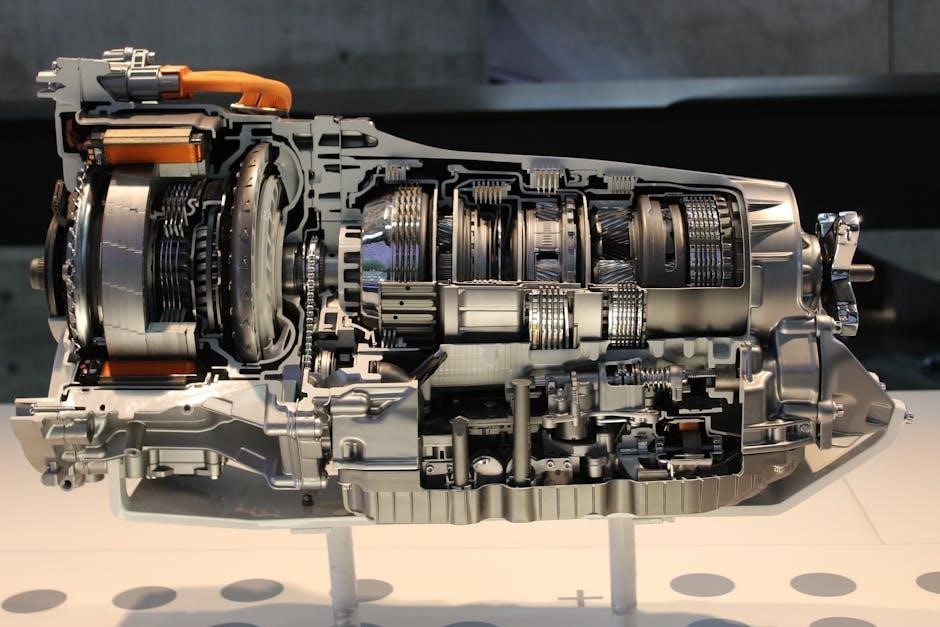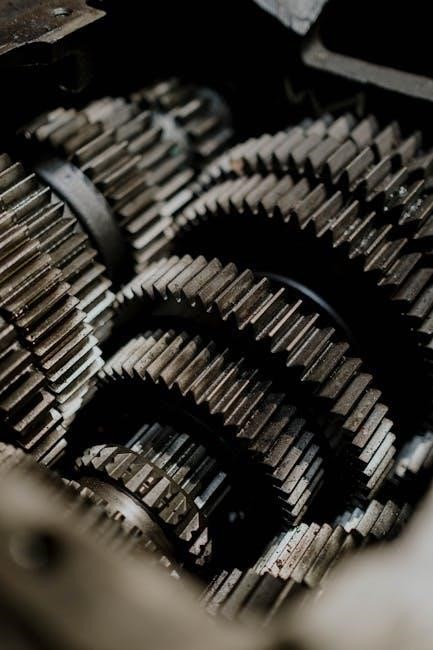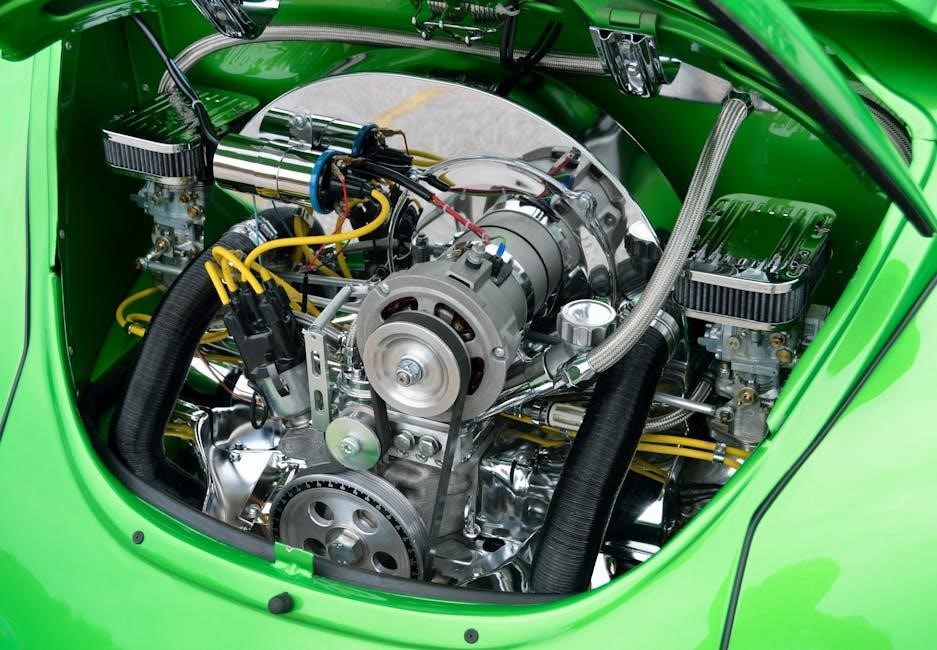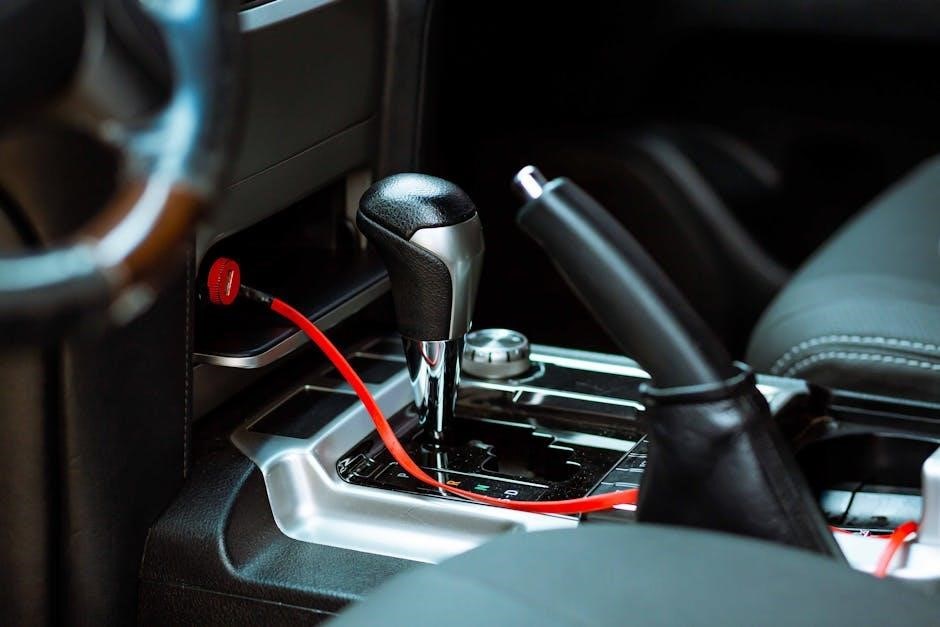Common Problems with Manual Transmission Gearboxes
Manual transmissions commonly experience clutch wear, gear grinding, fluid leaks, and noisy operation. These issues often result from driver error, inadequate maintenance, or high vehicle mileage.
1.1. Clutch Wear and Tear
Clutch wear and tear is a common issue in manual transmissions, often caused by improper shifting techniques, such as riding the clutch or sudden acceleration. Over time, this leads to friction and material loss, resulting in a slipping clutch and difficulty engaging gears. Regular inspection and proper driving habits can help prevent premature wear and extend the clutch’s lifespan.
1.2. Gear Grinding or Difficulty Shifting
Gear grinding or difficulty shifting is a prevalent issue in manual transmissions, often caused by improper synchronization or worn-out gear components. This can result in a grinding noise when shifting gears, especially when moving into first or reverse. If left unaddressed, it can lead to permanent damage to the gearbox, requiring costly repairs. Proper shifting techniques and timely maintenance are essential to prevent this issue.
1.3. Transmission Fluid Leaks
Transmission fluid leaks are a common issue in manual gearboxes, often caused by worn-out seals, damaged gaskets, or loose connections. These leaks can lead to low fluid levels, causing poor lubrication and increased wear on internal components. Regular inspection of the gearbox and fluid levels is crucial to prevent further damage. Addressing leaks promptly ensures optimal transmission performance and avoids costly repairs.
1.4. Noisy Operation
Noisy operation in manual transmissions can be caused by worn bearings, damaged gears, or low transmission fluid levels. Grinding, whining, or clunking noises during shifting often indicate internal component wear. Ignoring these sounds can lead to further damage, making repairs more expensive. Regular maintenance, such as fluid checks and inspections, is essential to prevent excessive noise and ensure smooth operation. Addressing the issue early helps maintain gearbox longevity.

Causes of Manual Transmission Gearbox Issues
Manual transmission issues often stem from improper shifting techniques, neglected maintenance, high mileage, and vehicle overloading, leading to premature wear and component failure over time.
2.1. Driver Error and Improper Shifting Techniques
Improper shifting, such as riding the clutch or shifting too abruptly, can cause significant wear on components like the clutch and gears. Inexperienced drivers may struggle with smooth transitions, leading to grinding gears or premature clutch failure. Additionally, failing to engage the clutch fully or using the wrong gear for speed can stress the gearbox, accelerating wear and potential breakdowns over time.
2.2. Lack of Regular Maintenance
Neglecting to check and maintain transmission fluid levels can lead to lubrication issues, causing gears to wear down faster. Failing to replace worn-out filters or inspect gaskets may result in leaks and contamination. Over time, this neglect can lead to grinding gears, difficult shifting, and eventual gearbox failure, emphasizing the importance of routine servicing to prevent such issues.
2.3. High Mileage and Wear and Tear
Over time, high mileage leads to natural wear and tear on gearbox components like gears, bearings, and synchronizers. This can cause difficult shifting, grinding noises, and reduced performance. Regular usage eventually degrades parts, especially if driving conditions are demanding. While some wear is inevitable, excessive mileage can accelerate deterioration, requiring earlier intervention to maintain smooth operation and prevent costly repairs.
2.4. Overloading the Vehicle
Overloading a vehicle puts excessive stress on the manual transmission, leading to premature wear of gears, bearings, and the clutch. This can result in difficult shifting, grinding noises, and even transmission fluid leaks. Consistently exceeding weight limits accelerates component failure, requiring costly repairs. Proper load management and adherence to manufacturer guidelines are essential to prevent such issues and extend gearbox lifespan.

Symptoms of a Failing Manual Transmission
A failing manual transmission often exhibits unusual noises, difficulty engaging gears, and vibrations or shuddering during operation. These symptoms can indicate worn or damaged components that require immediate attention.
3.1. Unusual Noises During Operation
Unusual noises, such as grinding, whining, or clunking sounds, often signal issues with the manual transmission. These noises may occur during acceleration, shifting gears, or when the clutch is engaged. They can indicate worn bearings, damaged gear teeth, or low transmission fluid levels, all of which require prompt attention to prevent further damage to the gearbox.
3.2; Difficulty Engaging Gears
Difficulty engaging gears is a common issue in manual transmissions, often caused by a worn clutch, improper shifting techniques, or low transmission fluid levels. This can result in gears failing to engage smoothly or slipping out of position. If left unaddressed, it may lead to further damage, such as gear tooth wear or synchro failure, requiring costly repairs.
3.3. Vibrations or Shuddering
Vibrations or shuddering in a manual transmission can indicate imbalanced drivetrain components, worn clutch components, or misaligned gears. This issue often manifests during acceleration or deceleration, causing an uncomfortable driving experience. If not addressed, it may lead to premature wear on gearbox components, emphasizing the need for prompt inspection and maintenance to prevent further damage and ensure smooth operation.

Diagnosing Manual Transmission Problems
Diagnosing manual transmission issues involves visual inspections, checking fluid levels, and listening for unusual noises. Professionals may also use diagnostic tools to identify specific component failures accurately.
4.1. Visual Inspection of the Gearbox
A visual inspection of the gearbox is a crucial first step in diagnosing issues. Look for signs of leaks, worn components, or physical damage. Check the transmission fluid for discoloration or metal shavings, which indicate internal wear. Inspect the gearbox mounts for cracks or looseness, as these can cause vibrations and instability.
Examine the clutch and gear components for excessive wear or misalignment. Ensure all bolts and connections are secure. A thorough visual check can often reveal the source of the problem before more invasive diagnostic methods are required. Regular inspections help identify potential issues early, preventing costly repairs down the line.
4.2. Checking Transmission Fluid Levels and Condition
Regularly checking the transmission fluid is essential for maintaining gearbox health. Locate the dipstick or consult your vehicle’s manual for specific instructions. Ensure the fluid level is within the recommended range and inspect its color and consistency. Dark or gritty fluid indicates contamination and may require a change. Neglecting fluid condition can lead to premature wear and costly repairs.
Always refer to your vehicle’s repair manual for guidance on fluid checks and maintenance schedules to prevent gearbox issues.

Repair and Maintenance of Manual Transmissions
Regular maintenance involves replacing worn components and changing transmission fluid. Addressing issues early prevents major repairs and extends gearbox lifespan, ensuring smooth and efficient performance over time.
5.1. Replacing Worn or Damaged Components
Replacing worn or damaged parts like the clutch, gear synchros, or bearings is essential for maintaining smooth operation. Early replacement prevents further damage and costly repairs. Always opt for high-quality, genuine components to ensure durability and performance. Regular inspections can help identify worn parts before they fail, minimizing downtime and extending the gearbox’s lifespan significantly.
5.2. Refilling or Changing Transmission Fluid
Regularly checking and refilling transmission fluid is crucial for maintaining gearbox health. Low or degraded fluid can cause grinding gears and wear. Use the correct fluid type to ensure smooth shifting. Change the fluid every 30,000 to 60,000 miles, or as recommended by the manufacturer, to prevent contamination and extend the gearbox’s lifespan. Clean fluid ensures optimal lubrication and reduces friction.

Cost of Manual Transmission Repairs
Manual transmission repairs vary in cost, with clutch replacements averaging $500-$1,500 and gearbox rebuilds ranging from $1,000 to $3,000. Prices depend on the extent of damage and location.
6.1. Cost of Replacing the Clutch
Replacing a clutch in a manual transmission typically costs between $500 to $1,500, depending on the vehicle’s make, model, and labor rates. The clutch kit itself can range from $300 to $700, while labor costs add $200 to $800. Additional expenses may arise if the flywheel or pressure plate needs machining or replacement, increasing the total cost further.
6.2. Cost of Rebuilding or Replacing the Gearbox
Rebuilding a manual transmission gearbox can cost between $400 and $1,200, while replacing it entirely may range from $1,000 to $3,000 or more, depending on the vehicle’s make and model. Labor costs vary widely, and using new or used parts can significantly influence the final price. Luxury or high-performance vehicles may incur higher expenses due to specialized components.

Preventative Measures to Avoid Gearbox Issues
Proper driving techniques, regular servicing, and maintaining correct transmission fluid levels are essential for preventing gearbox issues and ensuring longevity over time.
7.1. Proper Driving Techniques
Using the clutch and accelerator smoothly, avoiding riding the clutch, and shifting gears at the correct RPMs can prevent wear on the gearbox. Proper techniques, like not shifting gears while stationary and using the correct gear for inclines, reduce strain and extend the lifespan of the transmission components.
7.2. Regular Servicing and Inspections
Regular servicing, including checking transmission fluid levels and inspecting for leaks, is crucial for maintaining gearbox health. Replacing worn components like gaskets or seals early prevents major repairs. Annual inspections by professionals can identify potential issues before they escalate, ensuring smooth operation and extending the gearbox lifespan.
Lifespan of a Manual Transmission Gearbox
A manual transmission gearbox typically lasts 80,000 to 150,000 miles, depending on driving habits and maintenance. Proper care can extend its lifespan significantly.
8.1. Average Lifespan Based on Usage
A manual transmission gearbox typically lasts 80,000 to 150,000 miles, depending on usage and conditions. Aggressive driving or poor maintenance can reduce lifespan, while careful usage extends durability.
8.2. Signs of Wear and Tear Over Time
As a manual gearbox ages, common signs of wear include grinding gears, difficult shifting, and noisy operation. Over time, components like synchronizers, bearings, and gear teeth may degrade, leading to slipping gears or vibrations. Regular inspections can help identify these issues early, preventing costly repairs and ensuring smooth operation.

Manual vs. Automatic Transmission Comparison
Manual transmissions offer better fuel efficiency and lower costs but require driver engagement. Automatics provide convenience and ease of use, especially in traffic, but may lack the driving experience manuals offer.
9.1. Reliability and Durability
Manual transmissions are often considered more reliable and durable due to their simpler design and fewer components compared to automatics. They require less maintenance and are less prone to mechanical failure. Automatic transmissions, while convenient, are more complex and can be more expensive to repair. Manuals also tend to have a longer lifespan if driven properly, making them a preferred choice for durability-focused drivers.
9.2. Cost and Maintenance Differences
Manual transmissions are generally more cost-effective than automatics, with lower purchase prices and maintenance costs. They require less complex components, reducing repair expenses. Automatics, while offering convenience, often incur higher maintenance and repair costs due to their intricate systems. Manuals also tend to have longer service intervals, making them a budget-friendly choice for many drivers over the vehicle’s lifetime.

Troubleshooting Common Gearbox Problems
Troubleshooting involves identifying issues during driving, such as unusual noises or difficulty shifting. Visual inspections, fluid level checks, and diagnostic tests help pinpoint problems early to prevent further damage.
10.1. Identifying Issues During Driving
Drivers can identify gearbox issues by paying attention to unusual noises, such as grinding or whining during shifts. Difficulty engaging gears, slippage, or a clunking sensation while accelerating are red flags. Vibrations or hesitation between gears may indicate worn components. Regularly monitoring these symptoms and addressing them promptly can prevent minor problems from escalating into costly repairs.
Resources for Further Reading
Online guides, repair manuals, and forums offer detailed insights into manual transmission issues. Websites like Transmission Repair manuals and Gearbox forums provide practical advice and solutions.
11.1. Online Guides and Repair Manuals
Reputable websites offer detailed online guides and repair manuals for manual transmission issues. Resources like Transmission Repair Manuals provide step-by-step instructions, while forums such as Gearbox Enthusiasts share practical advice. Use Google’s advanced search to find specific PDFs or Word documents for in-depth troubleshooting. These resources are invaluable for DIY repairs and understanding complex gearbox problems effectively.
11.2. Forums and Communities for Gearbox Enthusiasts
Forums like Gearbox Enthusiasts and Transmission Repair Forums offer valuable insights and real-time advice. Enthusiasts share personal experiences, troubleshooting tips, and repair strategies. These communities are ideal for discussing specific gearbox models, DIY fixes, and seeking expert opinions. Active participation can help diagnose and resolve issues efficiently, fostering a collaborative environment for gearbox enthusiasts worldwide.